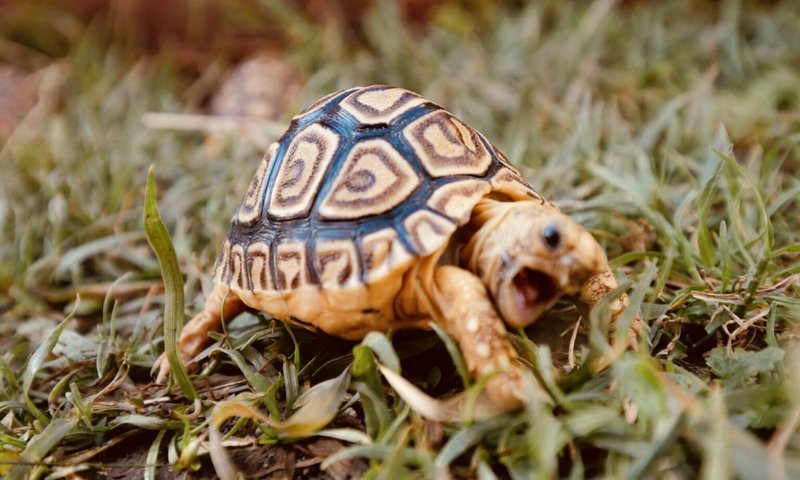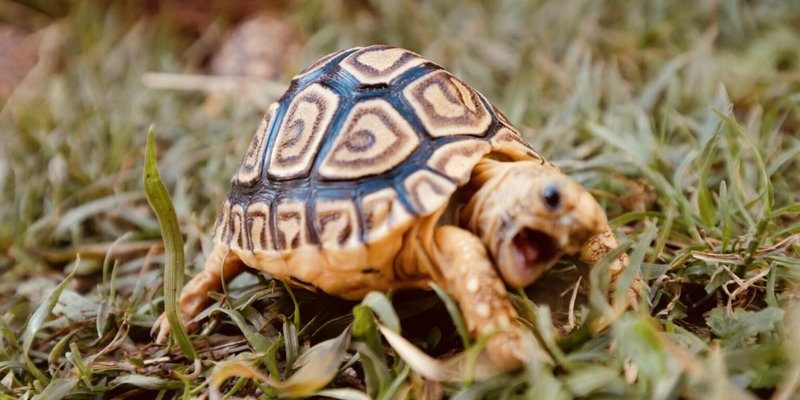
Leopard tortoises (scientifically known as Stigmochelys pardalis) are among the largest tortoise species in Africa. They’re easily recognized by their distinctive shell patterns—an intricate mix of yellows and dark browns that really do resemble a leopard’s spots. But what else should you know about them? Let me guide you through some key traits and characteristics that will help you spot a leopard tortoise from a distance.
Physical Characteristics of Leopard Tortoises
When you first lay eyes on a leopard tortoise, the first thing that grabs your attention is their shell. The shell, or carapace, is dome-shaped and covered with a striking pattern of dark spots that stand out against a yellow or light brown background. Think of it like a work of art; no two tortoises are identical. The patterns can vary significantly, with some having bolder spots than others.
Their shells can grow up to 19–24 inches in length, making them one of the larger tortoise species. If you see one wandering around your local park or in a pet shop, you might think, “Wow, that’s a big turtle!” but remember, tortoises are quite different from turtles. Tortoises are land dwellers and their feet are adapted for life on solid ground, whereas turtles have webbed feet or flippers for swimming.
Another feature to note is their weight. An adult leopard tortoise can weigh anywhere from 40 to over 100 pounds. If you see a tortoise that looks more like a mini tank than a delicate creature, you might be looking at a leopard tortoise. Just like a well-built car, their sturdy frame is part of their charm!
Color and Pattern Differences
You might wonder if all leopard tortoises look the same, but the truth is, there’s a wide range of color variations. The vivid yellow and dark patterns can be influenced by their habitat. For instance, those living in drier areas tend to have darker shells to absorb more sunlight, while those from lush environments might be lighter. It’s like how people from different parts of the world develop unique styles; the same goes for tortoises!
In younger tortoises, the patterns are more pronounced and brighter. As they age, the colors may fade slightly, but the iconic leopard spots remain. Juvenile leopard tortoises often have shells that appear more striking than adults, making them a favorite among pet enthusiasts. If you see a small tortoise with wild markings, it’s likely a younger leopard tortoise.
You might also notice their skin color can change throughout their lifespan. Generally, the skin is a darker shade, which contrasts beautifully with their lighter shell. Pay close attention because these subtle shifts in color can help confirm your identification when you’re out and about.
Habitat and Distribution
Understanding where leopard tortoises live can help in identifying them. They prefer the savannas, grasslands, and woodlands of sub-Saharan Africa. If you picture a wide, open space with patches of grass and scattered trees, you’ve got the right idea. They thrive in warm climates and enjoy basking in the sun, so you might find them lounging in the open, soaking up those golden rays.
In the wild, they often dig burrows or find shelter under bushes to escape the heat. If you’re trying to spot one in its natural habitat, look for areas with plenty of sunlight but also some shade. It’s like searching for your friend at a picnic; they’re likely to be in a spot where they’re comfortable but still in sight.
Leopard tortoises are also sometimes kept as pets. In this case, they’ll need a large space to roam, adequate heat, and a variety of plants and food choices. So, if you’re admiring a pet leopard tortoise, make sure you also consider its needs. A happy tortoise is a healthy tortoise!
Behavioral Traits
When you’re getting to know leopard tortoises, their behavior can give you clues about their identity. These tortoises are usually quite shy. While some animals flaunt their boldness, leopard tortoises prefer to retreat into their shells when they feel threatened.
If you see one slowly meandering through a garden, it’s likely just doing its tortoise thing: munching on grass or flowers. They’re curious creatures—if you approach slowly, you might see them pop their heads out to investigate. This behavior is part of their charm. It’s almost like they’re saying, “Hey there, I see you!”
Also, leopard tortoises are herbivores. Their diet mainly consists of grasses, leaves, and some fruits. If you spot one with a little greenery stuck to its snout, that’s a classic indicator of its diet choice. You might even notice them grazing, much like a lazy afternoon picnic.
Conservation Status
It’s crucial to mention that leopard tortoises are currently listed as “Near Threatened” on the IUCN Red List. Habitat loss and the illegal pet trade pose significant threats to their population. As you identify a leopard tortoise—whether in the wild or as a pet—it’s worth considering its conservation status.
If you see one being sold in a market or shop, it’s important to question its source. Ethical wildlife practices are vital for the survival of these beautiful creatures. You might think, “What can I do?” Simple. Supporting conservation efforts and avoiding purchases from questionable sources helps ensure future generations can enjoy these tortoises too.
So, when you’re out exploring and you come across a leopard tortoise, remember the signs: the striking spotted shell, shy demeanor, and humble lifestyle. They’re not just animals; they’re a reminder of the beauty and complexity of our world.
Identifying a leopard tortoise isn’t just about looking closely at their shell. It’s about understanding their behavior, habitat, and the unique patterns that make them stand out in the animal kingdom. Whether you’re hiking through the savannas of Africa or admiring one in a pet store, these tortoises offer a glimpse into a world that’s both fascinating and fragile.
Next time you come across a leopard tortoise, take a moment to appreciate its beauty and the role it plays in our ecosystem. Remember, every little bit helps in conserving these amazing creatures. Happy tortoise spotting!

